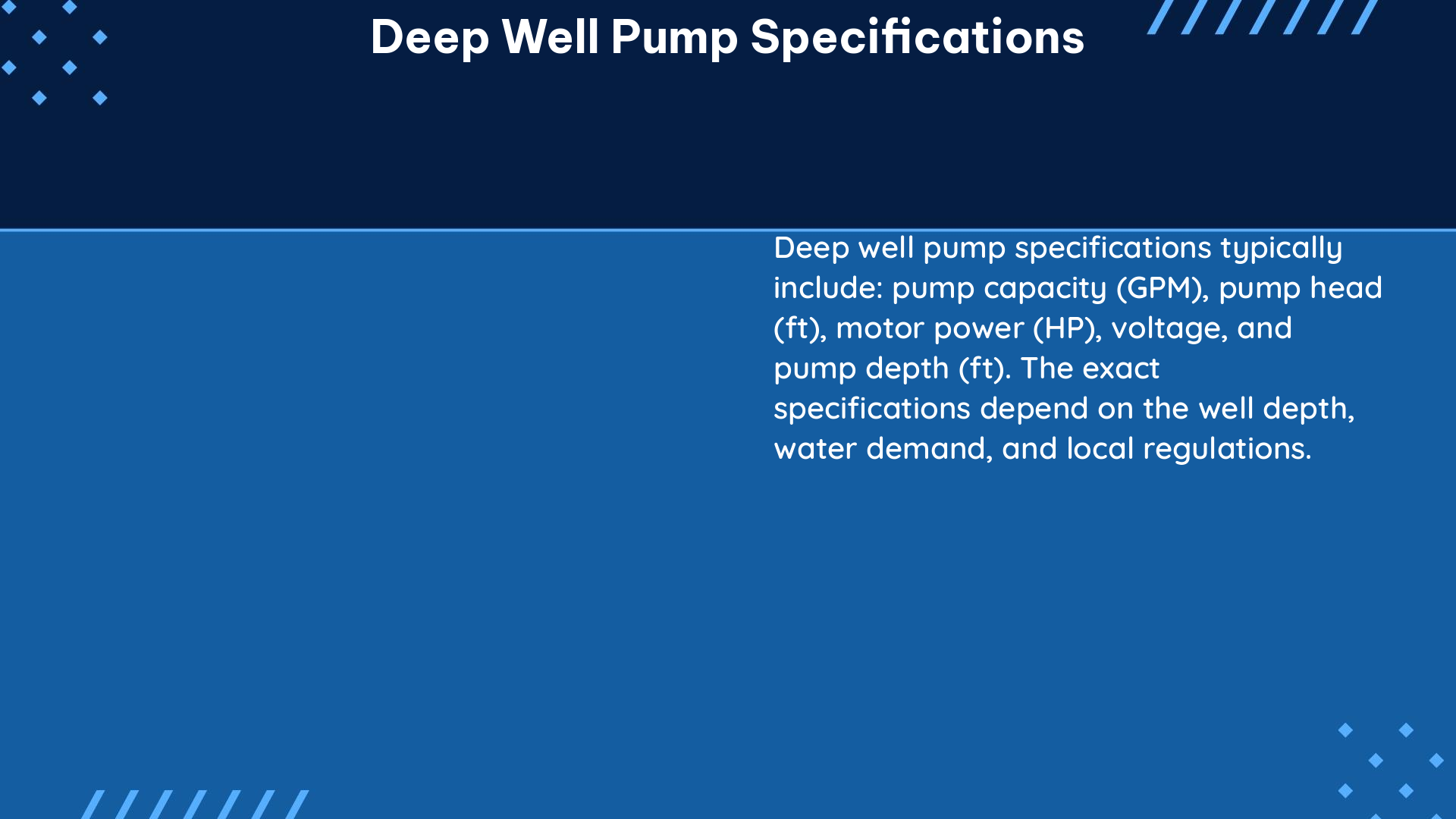When it comes to extracting water from great depths, deep well pumps are the go-to solution for residential, agricultural, and industrial applications. Understanding the intricate specifications of these specialized pumps is crucial for ensuring efficient and effective water extraction. This comprehensive guide delves into the key data points and technical details that define the performance and capabilities of deep well pumps.
Flow Rate (Q): The Lifeblood of Water Delivery
The flow rate, measured in gallons per minute (GPM) or cubic meters per hour (m³/h), is a critical specification that determines the pump’s ability to meet the water demand of a given application. A higher flow rate allows for faster water delivery, making it suitable for applications that require large volumes of water, such as irrigation systems or industrial processes. Typical flow rates for deep well pumps range from 10 GPM (37.8 L/min) for smaller residential systems to over 500 GPM (1,893 L/min) for large-scale agricultural or industrial operations.
Total Head (H): Overcoming the Vertical Challenge

The total head, measured in feet (ft) or meters (m), represents the total height that the water must be lifted, including the static water level, friction loss in the piping, and any additional lift required for the application. This specification is crucial for selecting a pump that can deliver water to the desired height, whether it’s for a multi-story building, a hilltop irrigation system, or a water tower. Deep well pumps can typically handle total heads ranging from 100 ft (30.5 m) for shallow wells to over 1,000 ft (304.8 m) for extremely deep wells.
Power Requirement (P): Powering the Pump’s Performance
The power requirement, measured in horsepower (HP) or watts (W), indicates the amount of energy needed to drive the deep well pump. This specification is essential for selecting the appropriate motor or power source, whether it’s an electric motor, a diesel engine, or a renewable energy system like solar panels. Deep well pumps can range from fractional horsepower (e.g., 0.5 HP or 373 W) for small residential systems to over 100 HP (74.6 kW) for large-scale industrial or agricultural applications.
Efficiency (η): Maximizing Energy Utilization
Pump efficiency, expressed as a percentage, represents the ratio of the pump’s output power (in terms of water flow and head) to its input power. A higher efficiency means the pump is converting more of the input energy into useful water delivery, resulting in lower operational costs and reduced energy consumption. Typical deep well pump efficiencies range from 50% for older or less-efficient models to over 80% for modern, high-performance pumps.
Pump Curve: Visualizing Performance
The pump curve is a graphical representation of the pump’s performance, illustrating the relationship between flow rate, total head, and power requirement. This curve is essential for selecting a deep well pump that can meet the specific demands of an application. By analyzing the pump curve, you can determine the optimal operating point, where the pump delivers the desired flow rate and head while operating at its peak efficiency.
Well Depth (D): Determining the Pump Configuration
The well depth, measured from the ground surface to the bottom of the well, is a crucial specification that dictates the required length of the pump column and the overall pump configuration. Deep well pumps are designed to operate at various depths, with typical ranges from 100 ft (30.5 m) for shallow wells to over 1,000 ft (304.8 m) for extremely deep wells. The pump’s construction and materials must be selected to withstand the pressure and environmental conditions at the well depth.
Static Water Level (SWL) and Dynamic Water Level (DWL): Understanding the Water Source
The static water level (SWL) is the depth from the ground surface to the water level in the well when the pump is not operating. The dynamic water level (DWL) is the water level in the well when the pump is running, which can vary depending on the pump’s flow rate and the well’s characteristics. These specifications are essential for determining the required lift and the pump’s suction capacity. Typical SWL values can range from 20 ft (6.1 m) for shallow wells to over 300 ft (91.4 m) for deep wells, while DWL can be significantly lower, depending on the pump’s flow rate and the well’s drawdown characteristics.
Pipe Size and Material: Optimizing the Delivery System
The size, length, and material of the piping used to transport water from the well to the application can significantly impact the friction loss and overall efficiency of the pumping system. Larger pipe diameters, such as 4-inch (10.2 cm) or 6-inch (15.2 cm) PVC or steel pipes, can reduce friction loss and improve the pump’s performance, but they also require more powerful and energy-intensive pumps. Smaller-diameter pipes, such as 2-inch (5.1 cm) or 3-inch (7.6 cm) pipes, may be more cost-effective but can result in higher friction losses and reduced flow rates.
By understanding these deep well pump specifications in detail, you can ensure that the selected pump is perfectly suited for your specific application, delivering water efficiently and effectively while minimizing energy consumption and operational costs. This technical playbook provides a comprehensive guide to the key data points and measurable factors that define the performance and capabilities of deep well pumps, empowering you to make informed decisions and optimize your water extraction system.
References:
– Deep Well Pump Specifications and Reverse Engineering
– Solar-Powered Water Pump Systems for Stockwater Design
– How Can I Find Out My Well Specifications or Measure My Well?

The lambdageeks.com Core SME Team is a group of experienced subject matter experts from diverse scientific and technical fields including Physics, Chemistry, Technology,Electronics & Electrical Engineering, Automotive, Mechanical Engineering. Our team collaborates to create high-quality, well-researched articles on a wide range of science and technology topics for the lambdageeks.com website.
All Our Senior SME are having more than 7 Years of experience in the respective fields . They are either Working Industry Professionals or assocaited With different Universities. Refer Our Authors Page to get to know About our Core SMEs.